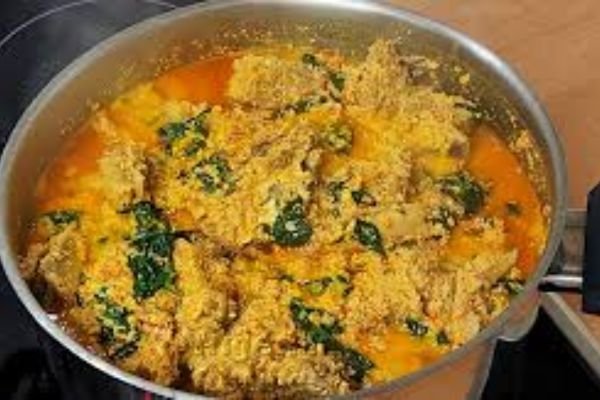Egusi soup is one of the most beloved dishes in West Africa, particularly in Nigeria, where it is a staple in many homes. Made from ground melon seeds, this rich and hearty soup is known for its unique nutty flavor, thick texture, and delicious combination of meats, fish, and vegetables. It is often enjoyed with swallows like pounded yam, eba, or fufu, making it a comforting and satisfying meal.
Beyond its delicious taste, Egusi soup holds cultural significance as it is commonly prepared for family gatherings, festive occasions, and traditional celebrations. Each region in Nigeria has its twist on the recipe, with variations in ingredients and cooking methods, such as frying or boiling the egusi to achieve different textures and flavors.
The boiling method of cooking Egusi soup is particularly popular for those who prefer a healthier, oil-conscious approach while preserving the soup’s rich taste. This method enhances the natural flavors of the Egusi seeds and other ingredients without the added step of frying, making it a great option for those
Ingredients Needed for Egusi Soup (Boiling Method)
Cooking a delicious Egusi soup using the boiling method requires the right combination of ingredients to achieve the perfect texture, taste, and aroma. Below is a detailed breakdown of the essential ingredients and their roles in making this rich and hearty West African delicacy:
1. Egusi (Melon Seeds) – Blended or Ground
Egusi, also known as melon seeds, is the star ingredient of this soup. It is derived from the seeds of certain gourds and is typically blended or ground into a fine or coarse paste before cooking. Egusi is rich in protein, healthy fats, and essential vitamins, making it a nutritious addition to meals.
-
Why it’s important: Egusi thickens the soup, giving it a creamy texture.
-
How to prepare: Blend dry Egusi into a fine powder or mix it with water to form a paste before adding it to the soup.
2. Protein (Meat, Fish, or Both)

Egusi soup is traditionally cooked with a variety of proteins, which enhance its flavor and make it more filling. You can choose to use just meat, fish, or a combination of both.
-
Common options for meat:
-
Goat meat – Adds a rich, gamey taste.
-
Chicken – Provides a lighter but flavorful option.
-
Beef – Commonly used for its hearty taste.
-
-
Common options for fish:
-
Stockfish (Okporoko) – Adds depth and an umami flavor.
-
Dry fish – Smoky and slightly chewy, enhancing the texture of the soup.
-
Fresh fish – Can be used but requires gentle handling to prevent breaking apart.
-
-
Why it’s important: The combination of meats and fish enhances the depth and richness of the soup.
3. Vegetables – Spinach, Bitter Leaf, Ugu (Fluted Pumpkin Leaves), or Kale
Vegetables not only add color to Egusi soup but also provide essential nutrients. The choice of greens depends on preference and availability:
-
Spinach – A soft, mildly flavored option that blends well with the soup.
-
Bitter leaf – Adds a slightly bitter taste; must be thoroughly washed to reduce bitterness.
-
Ugu (Fluted Pumpkin Leaves) – The most traditional choice, rich in vitamins and with a mildly sweet taste.
-
Kale – A good substitute if ugu is unavailable.
-
Why it’s important: Vegetables add nutrients, color, and balance to the richness of the egusi.
4. Palm Oil
Palm oil is an essential ingredient that enhances the color, taste, and authenticity of Egusi soup. It gives the soup its characteristic deep yellow-orange hue and adds a subtle nutty flavor.
-
Why it’s important: Palm oil provides healthy fats and improves the soup’s overall taste.
-
Alternative: If you prefer a lighter version, you can reduce the quantity of palm oil, but removing it completely changes the traditional taste.
5. Seasoning Cubes (Maggi or Knorr)
Seasoning cubes add depth and enhance the umami flavor of the soup. Popular brands include Maggi, Knorr, and Royco.
-
Why it’s important: It helps balance the flavors of the ingredients and intensifies the richness of the broth.
-
Alternative: Homemade seasoning blends or natural ingredients like fermented locust beans (iru or ogiri) can be used for extra depth of flavor.
6. Salt
Salt is a fundamental seasoning ingredient that brings out the flavors of the Egusi soup.
-
Why it’s important: It balances the overall taste of the dish.
-
Tip: Add salt sparingly at first, as seasoning cubes already contain some level of salt.
7. Crayfish (Ground)
Crayfish is a key ingredient in Nigerian soups that adds a distinct, savory seafood taste. It is usually ground into a fine powder before being added to the soup.
-
Why it’s important: It enhances the umami flavor of the egusi and complements the fish/meat.
-
Alternative: Ground shrimp or prawn powder can be used if crayfish is unavailable.
8. Pepper (Scotch Bonnet, Dried Chili, or Cayenne)

Pepper gives Egusi soup its spicy kick and enhances the overall depth of flavor. Different types of pepper can be used depending on personal spice tolerance:
-
Scotch Bonnet – Fresh and fiery, commonly used for a rich heat.
-
Dried Chili (Shombo or Cameroun pepper) – Adds a smoky and intense spice.
-
Cayenne Pepper—A milder alternative for controlled heat levels.
-
Why it’s important: Provides warmth and enhances the taste of the soup.
9. Onions (Optional but Enhances Flavor)
Onions are commonly used when boiling meat or making stock as they enhance the aroma and taste. Some people also add blended onions to the egusi paste for extra flavor.
-
Why it’s important: It adds a natural sweetness and depth to the broth.
-
Alternative: Garlic or ginger can be included for an extra twist.
10. Stock (From Cooked Meat/Fish)
The broth or stock obtained from boiling the meat and fish serves as the soup’s base, infusing it with a rich and meaty flavor.
-
Why it’s important: It adds depth and natural seasoning to the soup.
-
Tip: Use enough stock to allow the egusi to absorb the flavors properly, but avoid making the soup too watery.
11. Water (For the Boiling Process)
Water is essential in adjusting the consistency of the soup. The amount of water used depends on the desired thickness.
-
Why it’s important: Prevents the soup from being too thick or too dry.
Tip: Always start with less water and gradually add more to reach the right consistency.
Step-by-Step Instructions for Cooking Egusi Soup Using the Boiling Method
Step 1: Prepare the Ingredients
-
Wash and cut the vegetables.
-
Blend or grind the egusi seeds into a smooth or coarse paste.
-
Wash and season the meat and fish.
Step 2: Boil the Meat and Fish
-
In a large pot, boil the meat with onions, salt, and seasoning cubes.
-
Cook until tender and set aside the meat stock (broth).
-
Add fish later to avoid breaking apart.
Step 3: Add Palm Oil to the Stock
-
Pour palm oil into the pot of stock and mix well.
-
Allow the palm oil to blend into the broth before adding egusi.
Step 4: Add Ground Egusi to the Boiling Stock
-
Mix the blended egusi with a little water to form a paste.
-
Scoop small portions of the egusi paste into the boiling stock.
-
Cover and allow to cook for 15–20 minutes without stirring (this allows the egusi to form lumps).
Step 5: Stir and Add Crayfish and Pepper
-
Stir the mixture to break up any large lumps of egusi.
-
Add ground crayfish and pepper for enhanced taste.
Step 6: Add Cooked Meat and Fish
-
Return the cooked meat and fish to the pot.
-
Stir gently to combine with the egusi.
Step 7: Add Vegetables and Final Seasoning
-
Add the chopped vegetables and stir well.
-
Adjust seasoning with salt, more seasoning cubes, or additional spices if needed.
Step 8: Simmer and Serve
-
-
Let the soup simmer for another 5–7 minutes to allow the flavors to blend.
-
Turn off the heat and let it sit for a few minutes before serving.
-
Conclusion
Egusi soup, prepared using the boiling method, is a flavorful, nutritious, and hearty West African delicacy that is easy to make once you understand the right ingredients and cooking process. By following this guide, you can achieve a rich and delicious soup that brings out the best flavors of egusi while maintaining its authentic taste and texture.
The beauty of egusi soup lies in its versatility—you can personalize it by choosing different proteins, adjusting the spice level, or using your preferred vegetables. Whether served with pounded yam, fufu, eba, or rice, this dish is guaranteed to satisfy your cravings for a truly traditional and comforting meal.
Now that you have all the knowledge needed, why not try cooking Egusi soup today? Feel free to experiment with the ingredients, and don’t forget to share your experience with family and friends. If you have any questions or additional tips, drop a comment—we’d love to hear from you!







